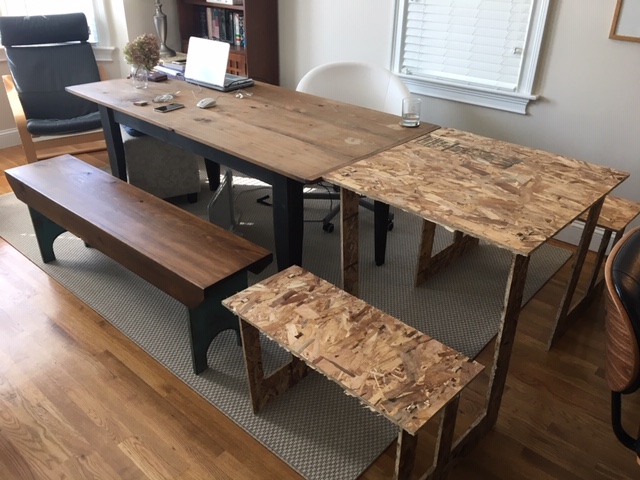Discovering the limits of OSB. Endeavored to create a quick-snap table to extend my dining room table to seat a few extra when reuqired. Found during testing that snaps I hoped to use would literally snap. Transferring files from Rhino to Mastercam for use on powerful Onsurd riddled with small traps. First, forgot to change orientation, so had to redo selecting curves. Then during "air run" with the help of the monitor, discovered that we didn't reset the whole path, so holes during "air run" were never milled. Finally, original onion skin was created with a combination of Mastercam and setting on Onsurd by previous monitor. Next monitor cleared OnSurd onion skin, causing a part to lift. Thankfully, I was able to stop the machine at once and my design was complete except for the support parts that coincidentally corresponded to the holes that were never drilled.
Designing the Temporary Table
I have a dining room table that can sit 8. I wanted a temporary solution if we had a few more people come over to quickly set up a table. I wanted to be able to put away the table when not in use. Also, as someone in the miltiary and now a student, I have done full moves 6 times since college. It would be nice if my furniture could easily dissassmble for packing and getting up third floor walk-ups.
Trying to Make the Snaps
So I did a test run with some scrap to see how the snaps would do. Turns out OSB is not the material to do this. The random peices of wood, means there is no grain and it means that the wood has random week points where it is brittle. You can see below that my cantelever snapped. I hope to try this again with better wood and use this as a protytpe for my final table extender.
Final design
I used blocks so I could change the snaps easily. I changed them into tabs. You can see my original plan and then download my final rhino file. I however found out that my blocks were hard to connect to my base design. That took some time joining each section.


Download final rhino file:
Fab Troubles
Had to come back Tuesday because the 1/8 inch bit broke on Monday night. Did not realize that until the mill grabbed an empty bit. Also turns out that the thickness of the board can vary significantly enough that slots sizes that work for one board, do not work for another. I based my thickness on Rafael's tests which showed 0.4 worked. But after learning from his redo, changed my holes to a full 7/16 inch. Also, had to redo all my countours because had the X/Y axis wrong on my mastercam file. Finally, during a change in monitors, my onion skin changed from the test snaps to my final product. Should do everything in one file, whehther that is the mastercam or through the machine. A part came loose and had to stop the process. So now, sitting on this prototype without the cross supports is not recommended.



Final table
Assembled in the house! Do like the extra seating. Will need to make a wider table. Without the support legs as designed, I am afraid to actually sit!







